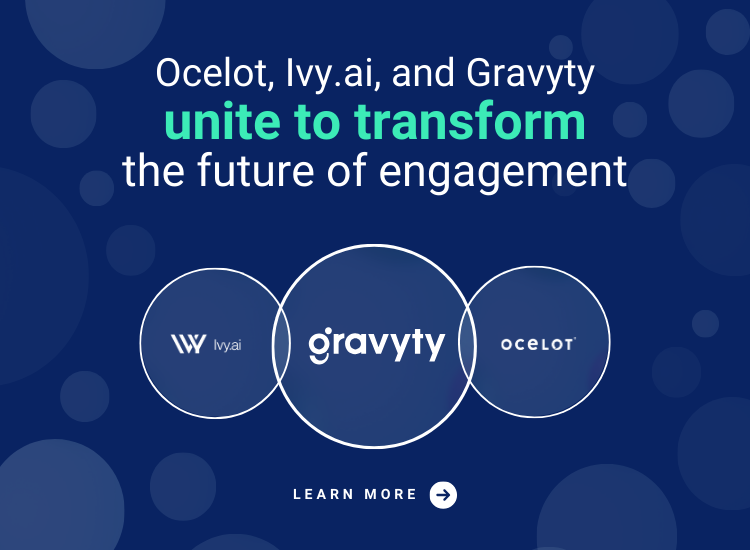Want to engage students, drive enrollment and improve retention rates all while gathering valuable data you can use to make better process, work-flow and communications decisions? You probably already know that a chatbot – designed for and by higher education professionals – can be a game-changing tool to support your admissions, financial aid and other student service departments.
If you’re considering a chatbot, you might wonder about the set-up and optimization processes.
At Ocelot, we have found that most schools spend about five to six hours per department to customize and launch their chatbot. We designed our platform to make it that easy. Here are eight best practices we recommend to our clients to ensure your chatbot works just as hard as – and operates as an effective extension of – your team.
1) Customize your welcome message
Even if your chatbot just says “Hey, I’m XYZ’s chatbot,” it’s important to give the user context about what your bot is capable of answering. Many of our clients personify their chatbot by giving it an avatar or name, and personality traits. At a minimum, make sure you’ve done your part to tell the user they’re interacting with a bot to help properly set their expectations.
2) Test your FAQs
We recommend testing your top FAQs against your chatbot’s content. When you input those questions, are you getting the correct answer(s)? What kind of menu results does the bot return? If you type in variations on those questions (that mean the same thing), are you still getting good results? Making sure your chatbot “knows” your FAQ page(s) inside-out is a good place to start when building a solid foundation for its future learning.
3) Link to resources when possible
Instead of returning specific deadline dates and answers within your bot, we recommend that chatbots reply with links to the webpages where that information “lives,” which should, of course, be dynamically updated on a regular basis. That way, users will always get the most current information and are directed to resources that can provide unrequested, but often useful details.
4) Develop a landing page
A chatbot landing page is a great way to build awareness of its capabilities among your users. And with smart SEO, the page helps ensure your bot appears at or near the top of search results, both within your site and on major search engines. Minnesota State University Mankato did this for its bot, Ask Stomper, creating a page that explains who Stomper is and what Ask Stomper can do. Boston University implemented a similar strategy with its Ask BUzz page.
5) Leverage video content
Ocelot supplies more than 1,400 videos on its platform – covering everything from how to effectively use the chatbot to financial aid tutorials to state-specific information like applying for California’s Cal Grant program. The videos play directly within the chatbot window, making the information quick and easy for users to access and digest. Plus, Ocelot’s platform offers a multilingual option, so if the student types a question in Spanish, the bot will converse in Spanish, and the videos provided will play with Spanish subtitles.
6) Monitor conversations
Chatbots are not “set it and forget it” tools. They evolve along with your needs (and your users’ ever-changing queries). So, it’s important to periodically review interactions between your bot and constituents. Your team should consider:
- What questions are students asking that your chatbot can’t answer?
- What is your process to fill in gaps for that content?
- What can you learn from the patterns you’re seeing in students’ input?
- What adjustments can you make based on these patterns?
For example, we’ve had clients learn that very few students understand what a disbursement is (or even how to spell it). Schools can identify these information gaps on the backend of the tool and adapt the programmed language accordingly, instead saying something like “payout from your student loan.” Reviewing students’ questions can help you improve communications to students across the board – not just in the realm of the chatbot.
7) Take your chatbot to the next level with live chat and two-way text messaging
Ocelot’s platform is integrated with live chat and text messaging options. If a student asks a question the bot can’t answer, it can suggest connecting them to a live chat agent when available. The full conversation with the chatbot is transferred over to the appropriate staff member, so the agent can review the student’s history and communicate with them directly through the platform – without changing the user experience. You can even seamlessly transition to a live video chat (like Zoom) if needed.
In the same way, Ocelot uses its AI knowledge base to respond to students via text messages. You can choose to have a member of your team do that live, but if one isn’t available, the platform will handle the task. You can even launch your own text campaigns – which are one of the best ways to reach students about time-sensitive issues. To make it easy for you, you can draw on Ocelot’s library of prepackaged text templates in the areas of Admissions, Financial Aid, Registrar, Academic Advising and more.
This combination and proactive and reactive communication provides deep flexibility and functionality with AI combined throughout. With chatbot, live chat and texting technologies all in one location, streamlined data collection means you can make data-driven decisions with ease. We built an ecosystem that, if you’re using all of the pieces of the platform in sync, becomes a flywheel guiding students through their entire journey.
8) Access other systems to provide personalized experiences in the chatbot
You can provide even more personalized responses to students by integrating your chatbot with other technology platforms like PeopleSoft or Ellucian’s Banner. Ocelot offers several drop-in integrations, pre-built configurable integrations and open API frameworks – so you can connect your bot to just about any student information system (SIS) or customer relationship management (CRM) software on the market. Users can log in with a single sign-on and view secure information about financial aid, reset their password and more — all part of one seamless user experience.
The Wrap
There are many chatbot options that exist on the market, but choosing which type of chatbot to use for your institution requires a fundamental understanding of the strengths and weaknesses of each model and how your users will leverage the technology tool.
Multi-tenant chatbots, like Ocelot’s, allow users to harness natural language processing, generating meaningful answers and information as a direct result of their queries. The tool exists as a mature, AI-powered bot from day one, meaning that your students, faculty and staff will experience positive and useful interactions from first use.
Want to learn more about how almost 500 educational institutions leverage Ocelot’s AI Communications and Student Engagement Platform to drive enrollment, retention and student success? Get a demo today!








